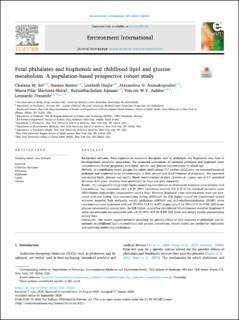| dc.contributor.author | Sol, Chalana M. | |
| dc.contributor.author | Santos, Susana | |
| dc.contributor.author | Duijts, Liesbeth | |
| dc.contributor.author | Asimakopoulos, Alexandros | |
| dc.contributor.author | Martinez-Moral, Maria-Pilar | |
| dc.contributor.author | Kannan, Kurunthachalam | |
| dc.contributor.author | Jaddoe, Vincent V.W. | |
| dc.contributor.author | Trasande, Leonardo | |
| dc.date.accessioned | 2022-09-02T11:20:38Z | |
| dc.date.available | 2022-09-02T11:20:38Z | |
| dc.date.created | 2021-01-19T21:31:29Z | |
| dc.date.issued | 2020 | |
| dc.identifier.citation | Environment International. 2020, 144 . | en_US |
| dc.identifier.issn | 0160-4120 | |
| dc.identifier.uri | https://hdl.handle.net/11250/3015401 | |
| dc.description.abstract | Background and aims
Fetal exposure to endocrine disruptors such as phthalates and bisphenols may lead to developmental metabolic adaptations. We examined associations of maternal phthalate and bisphenol urine concentrations during pregnancy with lipids, insulin, and glucose concentrations at school age.
Methods
In a population-based, prospective cohort study among 757 mother–child pairs, we measured maternal phthalate and bisphenol urine concentrations in first, second and third trimester of pregnancy. We measured non-fasting lipids, glucose and insulin blood concentrations of their children at a mean age of 9.7 (standard deviation 0.2) years. Analyses were performed for boys and girls separately.
Results
An interquartile range (IQR) higher natural log transformed third trimester maternal urine phthalic acid concentration was associated with a 0.20 (95% confidence interval (CI) 0.07–0.34) standard deviation score (SDS) higher triglycerides concentration among boys. Maternal bisphenol urine concentrations were not associated with non-fasting lipid concentrations during childhood. An IQR higher natural log transformed second trimester maternal high molecular weight phthalates (HMWP) and di-2-ethylhexylphthalate (DEHP) urine concentration were associated with a 0.19 (95% CI 0.31–0.07) respectively 0.18 (95% CI 0.31–0.06) SDS lower glucose concentration among boys. An IQR higher natural log transformed third trimester maternal bisphenol F urine concentration was associated with a 0.22 (95% CI 0.35–0.09) SDS lower non-fasting insulin concentration among boys.
Conclusions
Our results suggest potential persisting sex specific effects of fetal exposure to phthalates and bisphenols on childhood lipid concentrations and glucose metabolism. Future studies are needed for replication and exploring underlying mechanisms. | en_US |
| dc.language.iso | eng | en_US |
| dc.publisher | Elsevier | en_US |
| dc.rights | Attribution-NonCommercial-NoDerivatives 4.0 Internasjonal | * |
| dc.rights.uri | http://creativecommons.org/licenses/by-nc-nd/4.0/deed.no | * |
| dc.title | Fetal phthalates and bisphenols and childhood lipid and glucose metabolism. A population-based prospective cohort study | en_US |
| dc.title.alternative | Fetal phthalates and bisphenols and childhood lipid and glucose metabolism. A population-based prospective cohort study | en_US |
| dc.type | Peer reviewed | en_US |
| dc.type | Journal article | en_US |
| dc.description.version | publishedVersion | en_US |
| dc.source.pagenumber | 12 | en_US |
| dc.source.volume | 144 | en_US |
| dc.source.journal | Environment International | en_US |
| dc.identifier.doi | 10.1016/j.envint.2020.106063 | |
| dc.identifier.cristin | 1874946 | |
| cristin.ispublished | true | |
| cristin.fulltext | original | |
| cristin.qualitycode | 1 | |

